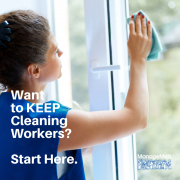Want to KEEP Cleaning Workers? Start Here.
When you were a small kid, what did you want to be when you grew up? A race car driver? A doctor? A park ranger?
Did you have hopes of joining the millions of people in the professional cleaning industry?
Probably not.
Heck, ask most people in the cleaning industry how they ended up in it, and most will say they fell into it. They answered a job ad, took a second job to pay for a big expense or offered to help out a friend for a weekend.
Current figures suggest approximately 2.5 million people work as cleaners in the U.S., and that’s probably a conservative estimate. But a lot of the people who begin working in the industry quit shortly after they start.
This happens for a lot of reasons—reasons you already know.
It’s hard work.
It doesn’t pay much.
It gets little respect.
Another thing we know? We’d be totally screwed without cleaning workers. Cleaning is essential for any high-performing organization—and society.
And right now, we’re experiencing a big issue of attracting and retaining talent. In Facility Cleaning Decision’s 2018 Reader Survey, staffing challenges were one of respondents’ top areas of concerns.
Historically low unemployment rates and stricter immigration policies are causing employers to look for alternative solutions, such as reducing frequencies and cross-training employees to cover labor shortages.
Changing Perceptions: It’s More than Just Dirty Work
Cleaning workers are an essential part of an organization. We know that, but in order to change the perceptions cleaning workers have of the work they do requires involvement from others within the organization.
A recent study looked at the social interactions of hospital cleaners and how those interactions impacted their perceived self worth. It looked at what researchers called “valuing acts” that cleaners experienced throughout the day and how those experiences made them feel.
Researchers stated, “A hospital’s effectiveness depends on the work of the cleaning staff…Those who clean hospitals ensure a safe and sanitary environment for the execution of routine and complicated medical procedures.” (p. 14)
So while the researchers recognized contribution of cleaners, they found their critical role wasn’t recognized by other people in the hospital.
Here’s what they found:
- Many cleaners recognize the importance of their work and take “great pride” in it.
- Their self worth is tied to social encounters they experience on the job — encounters with other people in the building, such as patients, nurses and doctors.
- Simple acts, like a doctor or nurse getting out of the way when the cleaner is pushing a cart through the hallway or acknowledging their presence with a simple nod contributes to a cleaning worker feeling valued.
- On the opposite side, acts like not cleaning up after themselves (e.g. not picking up paper that has fallen beside the waste basket or a spill for which they’re responsible) along with not involving them in a hospital wide event may contribute to the cleaners feeling unappreciated.
Ultimately, seemingly small gestures can leave a big impact on cleaning workers and can help them feel more valued—or devalued—within an organization.
How can we KEEP more cleaning workers?
Few people grow up wanting to be in the cleaning industry. The goal is to KEEP them in our industry once they get here.
How can you do this? Try following the KEEP acronym:
Keep employees at the forefront. Take the time to talk to your staff members and get to know them. Listen to them and learn the names of people in their families. Ask them questions and show you’re interested in them as a person, not just as a work.
Explain the importance of what they do. Help them understand the importance of their role. Make sure they know that cleaning isn’t just about helping a building look nice, but it’s about keeping people in that building stay healthy and safe too.
Empower them with training and advancement opportunities. Cleaning workers are one of the best customer service tools in your building. Empower them with training so they understand how to interact with others in the building and strategies to do their jobs better so they can be promoted and grow within their career.
Preach their importance to other people in the building. In a hospital, that might be doctors and nurses, in a school, that could be students and teachers. The key is that other people in the facility have a greater appreciation for how cleaning workers help them.
Studies routinely show that more engaged workers are higher performing. Showing workers that you truly value them will help KEEP them on your team in a competitive job market.
Check it out!
The short film “Keepers of the House” aims to highlight the importance cleaning workers. Developed to educate others in a hospital about the vital role housekeeping/custodial workers play in developing an environment of care, the film will be used as a learning tool to help create better, stronger businesses.


